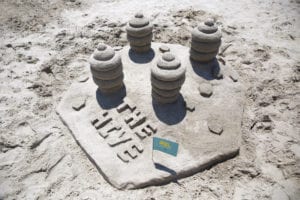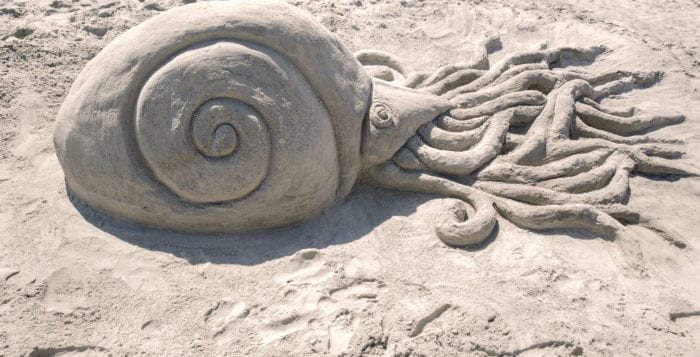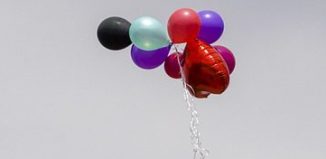Nesconset resident wins big at sand sculpture contest
In late May, more than 500 participants transformed Tybee Island, Georgia, into a temporary art gallery, created with sculptures made out of sand, and one Nesconset native dominated the scene.
Savannah College of Art and Design student Sabrina Shankar, majoring in production design, was on the team that took home the top prize, the SCAD Landmark Award, for their piece, “Pepe Hall.”
Shankar, 20, answered questions through email about her inspiration, sand sculpture and more.
How do you execute a sand art sculpture? What tools or materials are needed, and how long does it take?
When my partner Ryan Hurley and I decided to create a sand sculpture for SCAD’s Sand Arts Festival, we began planning out the whole process and prepared supplies immediately. The essential tools to creating a perfect sculpture include a bucket for water, a large shovel, a small shovel and sculpting tools.
Fortunately, I have taken SCAD’s ceramics course and had the sculpting tools needed to create fine lines. On the day of the event, Ryan and I split up tasks as one began to get water from the ocean and the other started creating a large mound of sand for the building.

Because Tybee Island’s sand is a little grittier, and the sun was very strong, we needed to add a bucket full of water to every couple of shovels of sand in order to keep the sand wet and sturdy for when we began sculpting.
How did you come up with the plan for the winning sculpture?
Ryan and I spent the morning of the competition carefully looking at the details that are found in architecture of SCAD’s Pepe Hall. We used Google Maps to screen shoot images of all sides of the building from multiple angles to take with us as inspiration.
Both Ryan and I wanted to create a SCAD landmark for the competition. When deciding on a building, we wanted to feature one that’s prevalent at SCAD and also had a castle-like feel to it. Additionally, Ryan is a fibers major so he spend a large portion of his studies in this building.
How and why did you first get interested in sand sculpture?
Ever since high school I have loved to sculpt. However, the first time I really became interested in sand sculpture was my freshman year at SCAD when we had a famous sand sculptor come in and display his work.
I always knew how challenging, time-consuming and rewarding this type of sculpture was, but seeing his work and hearing him talk about it intrigued me to try it. I later attended one of his workshops where he taught us all different tips and tricks on how to make the sculpture stand out in the crowd.
A few weeks later, I then competed in my first sand arts during freshman year at SCAD, and was fortunate enough to win in the SCAD landmarks category for creating Poetter Hall.
What are the hardest and most enjoyable parts of it for you?
The hardest part of creating a sand sculpture is the hard labor that goes into creating a large base. Besides the countless trips to the ocean gathering water, the shoveling process can be taxing and requires a lot of strength.
The most enjoyable part of creating a sand sculpture is the audience that comes by to check on your work and see how the progress is going. This past year, Ryan and I had an elderly man check up on us during the entire process and he would ask us questions, provide critique and most importantly display enthusiasm throughout the process.
Seeing both SCAD students and the Savannah public cheer us on was a rewarding process.
What was it like to win, how did you feel? What did it mean to you to win for your recreation of an iconic SCAD landmark?
Unfortunately, Ryan and I were unable to attend the winning ceremony due to other engagements, but I remember checking my phone that afternoon and seeing multiple missed calls from a variety of friends. I immediately called one back and she started screaming on the other line a congratulations we had just won SCAD’s Sand Arts Competition. I was so excited and called Ryan to share the good news. We couldn’t believe it, especially after seeing all of the other talented contestants but were extremely grateful.

Do you want to continue your sand sculpting career after college, and how?
I think it would be amazing to continue sand sculpting after graduating from SCAD, but in a variety of other aspects.
Why should more people start taking an interest in sand sculpture?
I think sand sculpting is a very unique art and although it is very challenging you can always see everyone smiling and having a good time no matter what their sculpture looks like. Events like the SCAD Sand Arts bring back memories of being a child and building a sand castle on the beach.
What lessons have you learned as an art student that helped you prepare?
As a production design major, I have been taught how to best display a space in order to convey the story I wish to tell. Through sand sculpting, whether it be replicating a building such as Pepe Hall or creating an out-of-the-world creature as a free-form sculpture, we are all trying to convey some sort of story. With every cut into the sand there was a purpose and special attention to detail in order to accurately represent Pepe Hall.
I believe that whether it may be SCAD Sand Arts, SCAD Sidewalk Arts Festival, the Savannah Film Festival, the SCAD FASHWKND or one of the many other signature events at SCAD, it is so important to participate and enjoy everything that SCAD is providing to us. These events always provide such a fun and engaging atmosphere and a welcomed break to the everyday studies. I always enjoy seeing all of the talent that SCAD students have that I may not see on a daily basis; not only does it provide inspiration, but it also allows me to meet new individuals for future collaborations.
What advice do you have for future art students?
If I had to provide advice to future freshman, upperclassmen or anyone in general, I would say they shouldn’t be afraid to try something new or give something your best shot even if you are uncertain of the outcome. Sometimes, the best kind of stories come from days when we are uncertain but decide to take a leap of fate and venture into a new path. Winning SCAD’s Sand Arts Competition not once, but twice during my three years has been some of my greatest accomplishments at this university and I would have never succeeded had I not tried.







